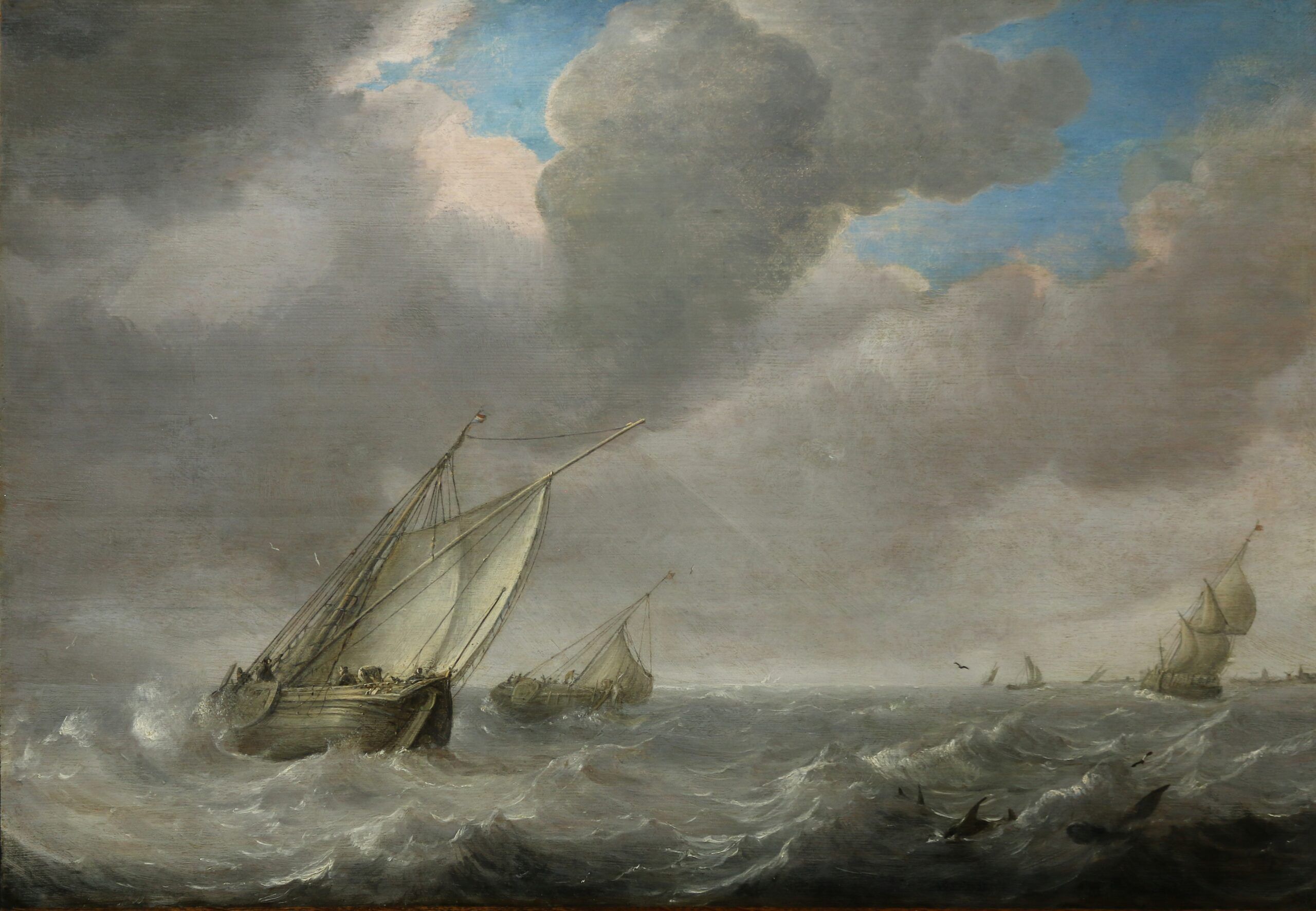The Hague ca. 1610 – The Hague 1663/73
Seascape with ‘Smalschepen’ offshore as a Storm approaches, with Dolphins in the Foreground
Signed ‘W V DIEST’, lower right
Oil on panel
H. 43.3 cm. W. 61.4 cm.
PROVENANCE
Sale Hugo Helbing | Frankfurt am Main | 27 November 1929 | Lot nr. 35 ill. 12 (as by Jan Porcellis) with ill.
With Kunsthandel F. Enneking | Amsterdam
Private collection
With Galerie Kurt J. Müllenmeister | Solingen | by 1970
Private collection
Sale Christie’s | Amsterdam | 7 November 2001 | Lot 76 with ill.
Private collection | Switzerland
LITERATURE
Bol, L.J. (1973). Die Holländische Marinemalerei des 17. Jahrhunderts. Braunschweig: Klinkhardt & Biermann, pp.163-164, with ill.
Müllenmeister, K.J. (1973). Meer und Land im Licht des 17. Jahrhunderts. Bremen: Carl Schunemann Verlag, Vol. I p.24, with ill.
EXHIBITION
Art and Antique Dealers’ Fair | Munich | 30 October – 9 November 1970 | Advertised in Apollo nr. 70 p. 122
CATALOGUE NOTE
‘Meester Willem, scheepschilder’ (‘Master Willem, painter of ships’), as he was described in the registers of the Guild of St. Luke, was among the leading marine painters in The Hague in the seventeenth century. Although his contemporaries Jan van Goyen and Abraham van Beijeren both painted marines, they were not specialists in the genre. Van Diest’s surviving oeuvre on the other hand consists exclusively of cabinet-sized marine paintings, of which the present picture is an excellent example. There are few dated paintings by van Diest so the exact chronology of his oeuvre is uncertain. He developed a wide repertory of themes, including calms, beach and river scenes, stormy seas and his preferred subject, shipping in breezy conditions. The subtle atmospheric seascapes of the marine painter Simon de Vlieger evidently made a deep impression on van Diest, as did the tonal marines of van Goyen. He nevertheless developed his own distinctive style, which is characterised by a somewhat monochrome palette. In his description of the present marine Müllenmeister (1970, p. 24) pointes out by the present work is characteristic of the artist, its impressive silvery-grey palette recalling the work of Jan Porcellis. In fact, the similarity is such that our picture pas sold by auctiuonhouse Hugo Helbing in 1924 as by Jan Porcellis.
Willem van Diest is first cited in 1631 at the baptism of his daughter Adriana in the Grote or Jacobskerk in The Hague. This evidence of paternity and other records suggest that the painter was born around 1610 and probably lived in The Hague. The 10th January 1634 saw the baptism of another child, whose name is unrecorded, but it may have been his son Jeronimus, who was to become a marine painter like his father. In 1634, he became a citizen of The Hague and in the same year he was paid 72 Flemish pounds by the city magistrates for the picture of a ship from Lubeck, which was rescued by The Hague militia. In 1636 and 1638 two more children were born: Adriana, the first daughter having died in the meantime, and Catharina. Van Diest is first mentioned in the records of the St. Luke’s Guild in 1639 as ‘Master Willem, painter of ships’ although he had probably joined the guild sometime before. A son, Joost, and a daughter, Elisabeth, were born in 1641 and 1644 respectively. Also present at their baptisms was Swaentje Coijmans, the painter’s legal or common law wife. In 1646, a son, Anthoni, was born, and in 1649, a daughter, Cornelia, at whose baptisms both the painter and Swaentje Coijmans were present. Contemporary documents indicate that the painter was frequently in debt. In 1656, Van Diest was among the founding members of the Confrèrie Pictura, the association of artists in The Hague which had broken away from the Guild of St. Luke. In 1657, he painted a marine for the boardroom of the brotherhood. In 1660, this painting became the subject of a dispute when the artist removed it from the chamber and the members felt obliged to have it brought back. His name occurs in a notarial document of 10 September 1663 stating that he would not be required to appear as a witness, but he was not present on 14 September 1664 at the baptism of a grandson named after him. It was therefore long assumed that he had died in the meantime, but the discovery of a signed and dated painting of 1668 indicates that he lived until at least that year.

